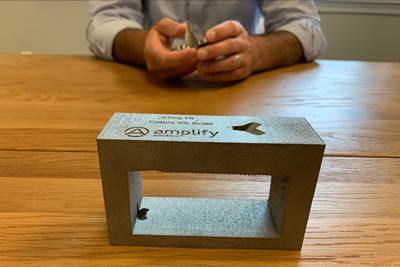Clamping Solution Facilitates Large-Part Vertical Machining
Mitee-Bite Products’ fixtures demonstrated their powerful clamping support in a project with Akron Gear & Engineering to vertically hold a 1-ton ring during machining.
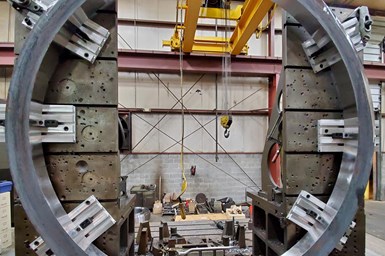
Mitee-Bite T-slot plates and Heavy Duty T-slot clamps securely held a 1-ton ring in a vertical orientation for machining.
Akron Gear & Engineering of Akron, Ohio, provides parts and service to a wide range of industries. This includes large machining jobs such as the ability to supply large industrial gears. Recently, the company had a problem to solve: One of its customers needed a 1-ton, 7-foot-diameter ring as soon as possible, but the shop’s vertical turning lathe was down for a complete overhaul.
Instead, it had to use its Juaristi horizontal CNC boring mill with 3+2 axis machining capabilities. The boring mill’s X- and Y-axis travels measure 118 and 95 inches, respectively, and the W axis measures 28 inches. The challenge was holding the ring in a vertical orientation. The stress from the weight of the part and the machine forces would overtax the workholding solutions the shop had on hand at the time, so it turned to Mitee-Bite Products.
According to Mitee-Bite’s General Manager David Bishop, sending the job overseas would have resulted in a “two-month transit time for ocean freight delivery; that cost alone could exceed manufacturing expenses.” As it turns out, by working with Mitee-Bite, the shop was making chips in less than 10 days.
Designing Workholding for a One-Piece Run
Akron Gear & Engineering’s Dennis Miller worked with Mitee-Bite’s Senior Applications Engineer Michael Witzgall to develop a modular, two-setup solution mounted on T-slot subplates. It would use Mitee-Bite’s Heavy Duty T-slot clamps in conjunction with Blunt Edge Pitbull clamps and large Multi-Fixture Stops for op. 1, then use Mitee-Bite’s Modular XYZ Xpansion Pins for machining the inner diameter (ID) and outer diameter (OD) and conducting other facing operations, leaving the part free from clamp interference.
The modular design was vital for avoiding distortion from clamping pressure in this application. As the large, one-piece run left little room for error, Akron Gear & Engineering and Mitee-Bite conducted an extensive brainstorming session and used CAD simulation software to optimize the workholding design. In the end, the T-slot subplates were machined flat with recesses on both the ID and OD so the boring bar would clear the edges during the finishing pass without contacting the plates. They mounted these plates centered on the ring’s diameter, placing the clamps and hard stops into a static position and equally applying contact pressure in small increments in all directions until the clamps achieved sufficient holding force.
Small Workholding for Large Parts

Mitee-Bite’s Pitbull clamps can exert up to 12,000 pounds of pressure.
In the first setup, they bolted or clamped the T-slot subplates onto the angle plates, and used the Pitbull clamps to hold the part. The Heavy Duty T-slot clamps with Pitbull clamps are capable of generating more than 12,000 pounds of pressure, though Mitee-Bite recommends using three T-nuts with tungsten carbide coating grips and a secondary TSN locking T-nut to secure the base at these high levels of force.
The Pitbull clamps “did exceptional work in the way they were designed,” Miller says. The only issue he encountered was that the position of the angle plates meant they could not prevent vibration between the top supports. With the ring’s crust proving harder than the material under the surface, machining the unsupported portion of the ring resulted in chatter marks. To remedy this, Miller used a 4-inch face mill to get through the surface before switching to the 6-inch face mill for a 0.060-inch depth of cut at a 90 ipm feed rate. (While this still caused vibration, it was slight enough that he could take a final pass using a 6-foot boring bar with a single point insert to finish the part.)
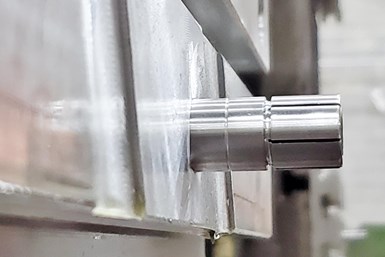
Op. 2 uses 16 mm threaded XYZ Xpansion pins.
After Miller milled and finished one face and drilled and reamed the holes in the part, op. 1 was done. He removed the ring to drill and tap holes into the subplates for the 16-mm Xpansion pins, and the plate went back on with very little effort, he says.
With the pins tightened down, he then milled the face of the second side and circle milled the ID and OD to 0.125 inch from the finish size.
Steady Solutions for Unique Problems
“The setup using the Pitbull clamps and Xpansion pins was the engineering of Mitee-Bite and their team,” Miller says. “They knew what obstacles we were going to face by going vertical, and the expertise they provided was spot on. Both the clamps and pins work as exactly as described, even with a part this large and heavy.”
While Akron Gear & Engineering plans to produce similar pieces on its VTL once it is back online, Miller notes that “if we get into a bind, I now have the capability of producing it on the Juaristi.”
Related Content
Lean Approach to Automated Machine Tending Delivers Quicker Paths to Success
Almost any shop can automate at least some of its production, even in low-volume, high-mix applications. The key to getting started is finding the simplest solutions that fit your requirements. It helps to work with an automation partner that understands your needs.
Read MoreFearless Five-Axis Programming Fosters Shop Growth
Reinvestment in automation has spurred KCS Advanced Machining Service’s growth from prototyping to low-and mid-volume parts. The key to its success? A young staff of talented programmers.
Read MoreCNC Machine Shop Honored for Automation, Machine Monitoring
From cobots to machine monitoring, this Top Shop honoree shows that machining technology is about more than the machine tool.
Read MoreHow to Mitigate Chatter to Boost Machining Rates
There are usually better solutions to chatter than just reducing the feed rate. Through vibration analysis, the chatter problem can be solved, enabling much higher metal removal rates, better quality and longer tool life.
Read MoreRead Next
Workholding Considerations for Five-Axis Machining
Five-axis workholding isn’t just about applying technology; it’s also about applying a different mindset.
Read MoreWhy Was This Block 3D Printed? To Help With Machining
This manufacturer making medical implants through additive manufacturing simplifies the machining by 3D printing the workholding fixture along with the parts.
Read MoreFixturing for Five-Axis CNCs
For some high-batch-size jobs and/or very complex parts, custom fixtures designed and manufactured in house enable Powill Manufacturing and Engineering to get the most out of its five-axis machining capability.
Read More

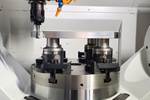
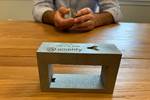
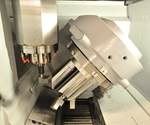





.png;maxWidth=300;quality=90)


.png;maxWidth=300;quality=90)











